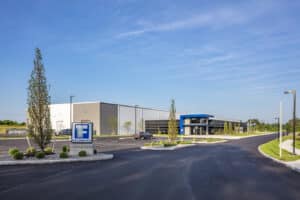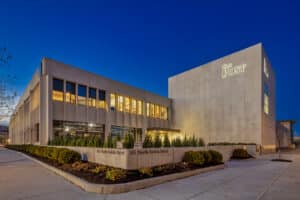Consumer expectations are fast evolving, and the line between online and offline shopping is blurring.
As a result, a retailer’s interior space needs to express the brand’s personality and identity while building an emotional connection with consumers to create a memorable shopping experience.
Understanding current retail trends, marketing technologies, and consumer psychologies is critical. Integrated design-build firms are equipped to work with clients to assist them in incorporating these trends seamlessly into their new retail spaces.
Mobile Retail and Data-Driven Personalization
Personalized marketing has proven to increase customer engagement and conversion while mobile technologies allow brands to bridge their online presence with offline customer experience.
Retail spaces can leverage technologies to deliver an instant personalized shopping experience. By incorporating kiosks, screens, and other display surfaces (e.g. mirrors), consumers can interact through their mobile devices to log into existing user profiles and access a customized retail experience that is highly relevant based on their purchasing history and preferences.
Craftsmanship, Quality & Community Connection
An experiential retail environment helps augment a brand’s unique positioning and develop an emotional connection with consumers. Many companies include a storytelling component in retail spaces to communicate the brand’s values and build a deeper connection with the audience.
For instance, some brands set aside a section in stores to demonstrate unique craftsmanship and processes, share the brand story, and/or showcase the unique care invested in the creation of products. Many of these stores also incorporate a tactile component to engage all senses while highlighting quality materials.
Automated Shopping Experience
While some parts of a store’s design should be “attention seizing” to generate buzz and amplify the brand identity, others should be “attention saving” to make the shopping experience as seamless and convenient as possible.
Incorporating components of automated-commerce into a retail environment can help streamline the shopping experience. Shoppers can focus on the experiential and brand storytelling components instead of worrying about finding the right size and color of an item, lining up to check-out, or arranging for deliveries.
“Instagram-friendly” Design
Consumers are expecting more than transactional activities when they visit a store in today’s “experience economy.” As more people are posting their experiences on social media, a shopping environment that’s worth documenting with photos or videos becomes a promotional tactic.
Retailers are incorporating elements that turn stores into brand destinations. These unique features (i.e. striking interior architecture, stunning color combinations, Instagram-worthy selfie opportunities, and innovative pop-up or VR experiences) invite shoppers to create and post these “shareable” moments.
Immersive Environment
When shoppers associate a company with a particular feeling, they’re more likely to develop an affinity for the brand. Successfully designed retail interiors appeal to every aspect of a shopper’s senses and evoke specific emotions to augment the customer experience.
A variety of elements can be used to stimulate the senses (i.e. lighting, texture, spatial arrangement, color, sound, smell) and create a visceral experience that’s on-brand, attractive, and memorable. Brands are also bringing nature into the retail environment by introducing plants, open spaces, and natural light to help promote a sense of wellbeing, reduce shoppers’ stress levels, and increase consumer interaction within the space.
In Summary
Consumers are demanding more transparency from brands and taking into consideration a business’s values and culture when making purchase decisions. The goal is to create a progressive brand that embodies diversity and inclusivity not only in its marketing campaigns, but also in the manufacturing processes, products, services, store environment, and customer engagement.
Today’s retail environment should express a brand’s values and reflect the corporate culture, while showcasing how these unique points of view are expressed through its products and services.
Learn More about VIP Structures
As a fully integrated design-build firm, we specialize in architecture, engineering, construction, and development to help organizations with building needs all across Upstate New York.
Visit us on the web at www.vipstructures.com or contact us below by filling out our short form. Subscribe to our blog to get the latest news about what is happening in the A/E/C/D world.



